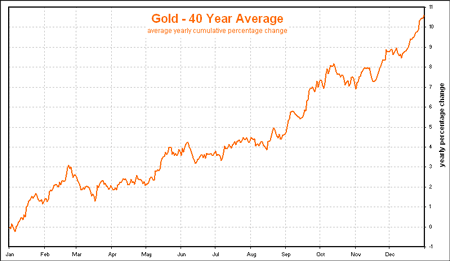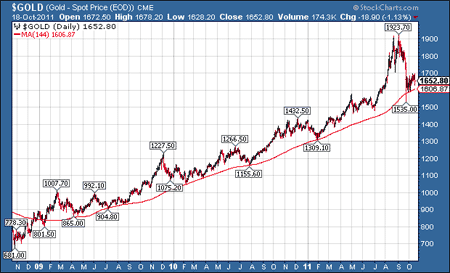I'm not sure we are going to see new highs in gold any time soon.
In fact, I'd wager some meaningless nickel coins that we've already seen the high for 2011. (The $1,923 an ounce level that was set in early September).
But I would also argue that we've seen the lows for the year as well.
MoneyWeek
Subscribe to MoneyWeek today and get your first six magazine issues absolutely FREE

Sign up to Money Morning
Don't miss the latest investment and personal finances news, market analysis, plus money-saving tips with our free twice-daily newsletter
Don't miss the latest investment and personal finances news, market analysis, plus money-saving tips with our free twice-daily newsletter
After its summer excesses, which were duly chastened when gold fell almost $400 in a week, I would argue that gold is now stabilising nicely above $1,600.
And I suggest that, for those of you that don't have a position, now is a good time to get one.
What does gold normally do at this time of year?
Of course you could listen to the perma-bears, who have predicted as many as 17 of the last five corrections in gold, and decide that gold is in a bubble; that it has no use so what's the point?; that we're in deflation, so gold will fall; or write it off because it doesn't pay any interest.
That's fine by me. Go ahead. I will sit on my little pot of gold and occasionally taunt you. Or eat a large portion of humble pie, if you prove to be right. (Which you won't).
Meanwhile, for those who don't already have a position, or who are looking to increase an existing one, I think an opportunity to get long is about to present itself.
I like to use a mixture of fundamental analysis why would this market rise or fall? and technical analysis (TA). Too much reliance on either one does not suit me. I like to marry the two.

James McKeigue explains the best ways to buy gold coins and bars.
I know that gold is in a bull market. I know and understand the fundamental arguments for gold currency debasement, negative real rates, a banking crisis, monetary stress, a global debt horror fiasco, several thousand years of history and so on. So there are my fundamentals.
A lot of wiser heads than mine knock TA, but I like it. Once I have my fundamentals in place in my mind, TA helps me to identify entry points, exit points and apply some money management. In other words, the fundamentals help me to decide on an investment path, and TA helps me to navigate the journey.
Let's first consider the seasonal patterns for gold. This first chart below shows the average monthly moves of gold over the last 40 years. Normally, you would expect to see a strong move in gold in early October which we have had followed by a decline in the second half of the month.
We appear to now be experiencing that too. Gold began the week at $1,680, went as low as $1,630 yesterday before rallying to $1,660.

I like to be aware of seasonal patterns, but, for me, they are a secondary, not a primary trading indicator. September, for example, is usually a strong month for gold. This year it was horrible. So I don't rely on seasonals.
(My thanks, as always, go to Nick Laird of www.sharelynx.com for the chart. Incidentally, I interviewed Nick this week in my podcast he had some extremely interesting insights. This will be uploaded to my site later in the week).
A good buying opportunity is coming up
What has, however, become one of my primary technical indicators for gold is the 144-day moving average (144-dma). This shows the average price of gold over the last 144 days. Perhaps it's coincidence, or perhaps it's because 144 is a Fibonacci number, I don't know. But the 144 dma has proved to be an astonishingly reliable bottom-caller since 2009. It seems to have caught the lows once again.
If you look at this next chart, you will see the gold price with, underneath, a red line, which is the 144-dma. Gold's slides, since 2009, always seems to halt here. (It slipped through briefly a fortnight ago, but this was outside of New York trading so we will cut the 144-dma some slack).

It was the trader Michael Hampton who first alerted me to this average, so credit where credit's due. I was the first, I think, to write about it, but it's now finding some renown in the gold-watching blogosphere. Sadly with these things, the more people that are aware of it and use it, the less they work.
But we can worry about that if and when it happens.
Gold currently sits at $1,650. The 144-dma lies at $1,606 and rising. I dare say the two will meet in the coming fortnight, which is when you should be looking to get long. Leave some orders in the $1,610 to $1,630 area maybe? And, if you want to play it really safe, put in a stop loss somewhere beneath that red line.
Gold will never fall below £1,000 an ounce again
As for gold in pounds, I would say buying as close to £1,000 an ounce as you can get makes a great deal of sense. I like making bold pronouncements, so why don't I give you one here? Gold will never fall below £1,000 an ounce again. Triple-digit gold, in sterling terms, is a thing of the past.
The current price by the way is £1,050 an ounce, so I'm cutting it pretty fine and could easily end up with egg on my face. But I'm making this call as much out of sterling bearishness, as I am gold bullishness.
In short, even though I suspect we've seen the highs for the year in gold, we can expect new highs some time in 2012. Now is an opportunity to position yourselves to enjoy them.
Our recommended article for today
The grim discovery that's spooked the City
The capital asset pricing model a popular system for valuing shares relied on risk-free government bonds for a yardstick. But now that government bonds are no longer risk free, the model is bust, says Tim Bennett. So what happens now?
This article is taken from the free investment email Money Morning. Sign up to Money Morning here .
Get the latest financial news, insights and expert analysis from our award-winning MoneyWeek team, to help you understand what really matters when it comes to your finances.
MoneyWeek is written by a team of experienced and award-winning journalists, plus expert columnists. As well as daily digital news and features, MoneyWeek also publishes a weekly magazine, covering investing and personal finance. From share tips, pensions, gold to practical investment tips - we provide a round-up to help you make money and keep it.
-
 Why pension transfers are so tricky
Why pension transfers are so trickyInvestors could lose out when they do a pension transfer, as the process is fraught with risk and requires advice, says David Prosser
-
 The political economy of Clarkson’s Farm
The political economy of Clarkson’s FarmOpinion Clarkson’s Farm is an amusing TV show that proves to be an insightful portrayal of political and economic life, says Stuart Watkins

